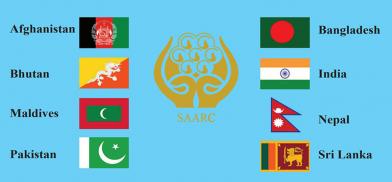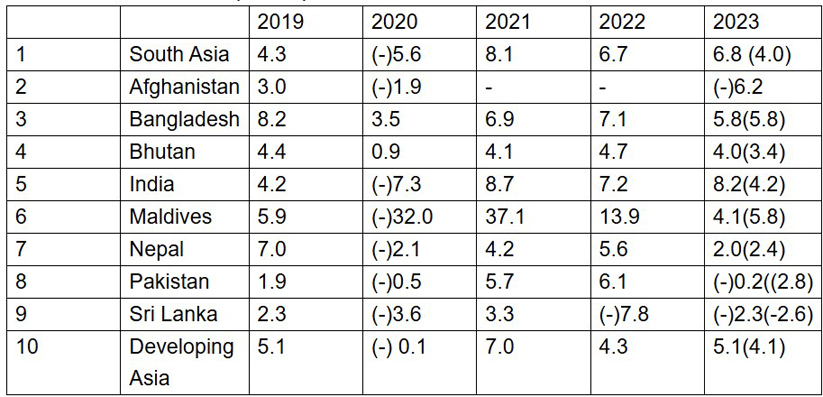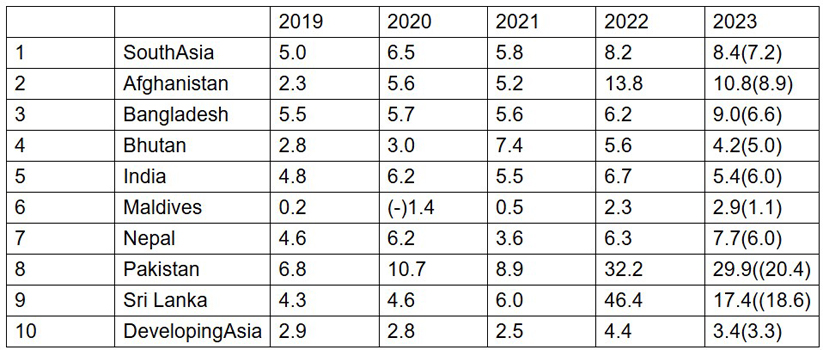South Asia: Redistributive growth needs to be the mantra for policymakers
It is estimated that about 37% percent of the world’s 1.1 billion multi-dimensionally poor people live in South Asia. And an estimated 272 million poor people in the region live in households with at least one undernourished person.

India recently unveiled a $760mn assistance for the Maldives. India’s central bank had agreed currency swap lines of $400mn under the USD/Euro swap window and Rs30bn under the INR swap window ($357mn) to the Maldives. The Maldives’ net foreign exchange reserves fell to about $36mn in September 2024, which showed the nature of the crisis staring at the dollar-pegged rufiyaa currency of the country. India earlier rolled over $100mn of short-term dollar loans this year, allowing the country to make an interest payment on a $500mn Islamic sukuk(similar to a bond but structured to comply with Islamic law) which is due next year.[i] A currency swap line is an agreement between two central banks to exchange a cash flow in one currency against a cash flow in another currency on predetermined terms and conditions.The agreement with Maldives is valid till June 18,2027.
External gross financing needs of Maldives have increased due to (i) high commodity prices, (ii) a more expansionary fiscal stance amid increases in capital project related spending, subsidies,and recurrent expenditures, and (iii) repayments and rollovers of non-concessional debt,mainly global sukuk. External Refinancing pressures are expected to peak in 2026.[ii]
Given that the Maldives is highly vulnerable to climate change, early actions to control debt vulnerabilities will help support the Maldives’ efforts to scale up the much-needed climate adaptation investments in a resource constrained context.[iii]
For Sri Lanka the IMF Executive Board completed the 2024 Article IV Consultation and Second Review under the 48-month Extended Fund Facility(EFF) with Sri Lanka, providing the country with
immediate access to SDR 254 million (about US $336 million) to support its economic policies and reforms.The EFF arrangement for Sri Lanka was approved by the Executive Board on March 20, 2023.[iv]
For Pakistan, the Executive Board of the International Monetary Fund (IMF) completed the second and final review of Pakistan’s economic reform program which allows for an immediate disbursement of SDR 828 million (around $1.1 billion), bringing total disbursements under the arrangement to SDR 2.250 billion (about $3 billion).Pakistan’s 9-month SBA, which was approved by the Executive Board on July 12, 2023, provided a window to address domestic and external imbalances as well as a framework for financial support from multilateral and bilateral partners. The program focused on (i) necessary fiscal adjustment and maintenance of debt sustainability via FY24 budget implementation; (ii)protection of critical social spending; (iii) buffering external shocks and eliminating foreign exchange shortages through proper foreign exchange market functioning; (iv) making progress on disinflation by maintaining a tight monetary policy; and (v) ensuring further progress on structural reforms, focused on energy sector viability, governance, and climate resilience.[v]
For Bangladesh, the Executive Board of the International Monetary Fund (IMF) completed the first review under the EFF and Resilience and Sustainability Facility arrangements allowing the authorities to withdraw the equivalent to SDR 352.35 million (about US$468.3 million) under the EFF, and SDR 166.67 million (about US$221.5 million) under the RSF. These arrangements for Bangladesh were approved by the Executive Board on January 30, 2023 to expand the fiscal space to finance climate investment priorities identified in the authorities’ plans, help catalyse additional financing, and build resilience against long-term climate risks.[vi]
Important countries of the South Asia region face the three critical issues which many parts of the world are facing at the moment- tackle climate change and accessing climate finance ,debt sustainability and price stability.These issues are the underlying features of the growth process which the region has seen in recent years.
Growing share of Asia in World GDP
Table One :Share in world GDP

EMASIA: Emerging & Developing Asia ,AE:Advanced Economies,EMDE:Emerging Market and Developing Economies
Source :IMF World Economic Outlook (WEO)(Statistical Appendix) Various years
Table one shows the place of emerging market Asia in the world today with its share in world GDP steadily rising between 2007 and 2023. China and India have been important countries in this growth process. We also see a decline in the share of world GDP of Advanced Economies with the share of US in this decline being important.While the share of Emerging Market Developing Economies as a bloc in the world GDP has risen by about 15% ,Asia has played a significant role in the rise with its share accounting for more than 85% of the rise. [The regional breakdowns of Emerging Market and Developing Economies mentioned in the WEO include Emerging and Developing Asia; Emerging and Developing Europe (sometimes also referred to as “central and eastern Europe”); Latin America and the Caribbean; Middle East and Central Asia (which comprises the regional subgroups Caucasus and Central Asia; and Middle East, North Africa, Afghanistan, and Pakistan); and sub-Saharan Africa][vii]
Growing share of Asia in World Exports of Goods & Services
Table Two:World Share of Exports of Goods & Services

Source: Same as Table One
Table two shows a similar trend as table one.World share of exports of goods services of Emerging Market Asia has increased between 2007 and 2023 while the share of Advanced Economies declined during this period. The relative increase and decline has been less significant than that of GDP, which is attributed to the tariff and nontariff barriers which developing economies face in world markets and the relative strangle -hold of the Advanced Economies on these markets in terms of market entry and trade barriers for EMDEs. Asia’s share is significant in the rise in the share of exports EMDEs.
Growth is projected to remain steady at 3.2 percent in 2024 and 2025, but some low-income and developing economies have seen sizable reversal in growth revisions, often linked to intensifying conflicts in their region. In Advanced Economies, growth in the United States is strong, at 2.8 percent this year, but expected to move higher in 2025. For advanced European economies, a modest growth rebound is expected next year, with output approaching potential. The growth outlook has been projected to be very stable in Emerging Markets and Developing Economies, around 4.2 percent this year and next, with continued robust performance of 6.4 percent for South Asia.[viii]
South Asia in the Asian perspective
Table Three; South Asia-per -capita GDP Growth rates

Source:Asian economic Outlook,(ADBI ,various Issues) Note: Figures in brackets give the average growth between 2020and 2023
Table three attempts to place South Asia in the Asian perspective. The table shows that developing Asia has maintained a relatively stable growth trajectory as compared to South Asia. But overall South Asia has achieved an average growth rate almost that of developing Asia.While Bangladesh,Pakistan and Sri Lanka had approached IMF for assistance in recent years, the latter two countries have achieved much lower growth rates during 2019 to 2023.Data on the average annual growth rates for the period 2020-23 shows that almost all countries in the region have not yet been able to reach the growth rate which they witnessed before the onset of the COVID-19 pandemic in 2019.
Growth and price stability
Price stability is an important factor in the entire economic story to which we shall now turn to
Table Four:Annual rate of inflation.

Source:Same as Table Three, Note Figures in brackets give the average growth between 2020 and 2023
Data in table four shows that the inflation rates in the South Asia have far exceeded the developing Asia region .The onset of the COVID-19 pandemic and thereafter has been particularly harsh with prices spiralling in the region primarily due to bottlenecks arising out of supply bottlenecks for food items and supply chain issues for imports especially from China.
Vulnerability to geoeconomic risks
For most South Asian countries, FDI has limited vulnerability to geopolitical shocks, largely because of their exceptionally low FDI inflows. Geoeconomic vulnerabilities in South Asia have fallen more than in other EMDEs since 2016,after which trade- and investment-restricting measures began to be used more widely around the world.But there was considerable heterogeneity in such vulnerabilities among countries of the region. In South Asia, these factors have sometimes neutralised each other, and sometimes worked in the same direction depending on their alignment for FDI ,portfolio capital and export markets. [ix]
Growth and poverty
It is estimated that about 37% percent of the world’s 1.1 billion multi-dimensionally poor people live in South Asia. And an estimated 272 million poor people in the region live in households with at least one undernourished person.
In Afghanistan the incidence of poverty rose by more than 5 percentage points from 2015/2016 to 2022/2023. In 2022/2023 nearly two- thirds of Afghans were poor (64.9 percent), and almost three of every five poor people were children. The global Multidimensional poverty Index (MPI ) measures acute multidimensional poverty across more than 100 developing countries .It was first launched in 2010 by the Oxford Poverty and Human Development Initiative (OPHI) at the University of Oxford and the Human Development Report Office of the United Nations Development Programme. Computation of the global MPI involves constructing a deprivation profile for each household and person covering 10 indicators of health, education and standard of living . All indicators are equally weighted within each dimension. The global MPI identifies people as multidimensionally poor if their deprivation score is 1/3 or higher.[x]
While South Asia emerges as one of the high growth areas, pervasive poverty also has been an integral feature of this growth.The need therefore is to have a growth process with better redistributive features. The challenge for policy makers and development practitioners in South Asia is to trigger a growth process that is inclusive and leaves few communities out in the margins.
(The writer is a retired special secretary, Government of India, and an economic affairs commentator. Views are personal. He can be reached at ppmitra56@gmail.com)
[i] India bails out Maldives after president softens tilt towards China
Financial Times,Oct7,2024https://www.ft.com/content/9423cd18-e8fa-4a6e-8078-ae23123f7ba9
[ii] MALDIVES
IMF STAFF REPORT FOR THE 2024 ARTICLE IV CONSULTATION—
DEBT SUSTAINABILITY ANALYSISMarch 5, 2024
[iii] Maldives: 2024 Article IV Consultation-Press Release; Staff Report; and Statement by the Executive Director for Maldives May 13, 2024https://www.imf.org/en/Publications/Search#q=IMF%20STAFF%20REPORT%20ON%20MALDIVES%20&sort=relevancy
[iv] SRI LANKA
2024 ARTICLE IV CONSULTATION AND SECOND
REVIEW UNDER THE EXTENDED FUND FACILITY,
REQUEST FOR MODIFICATION OF PERFORMANCE
CRITERION, AND FINANCING ASSURANCES REVIEW—
PRESS RELEASE; STAFF REPORT; AND STATEMENT BY
THE EXECUTIVE DIRECTOR FOR SRI LANKAJune 2024https://www.imf.org/en/Publications/Search#q=IMF%20STAFF%20REPORT%20ON%20MALDIVES%20&sort=relevancy
[v] PAKISTAN
SECOND AND FINAL REVIEW UNDER THE STAND-BY
ARRANGEMENT—PRESS RELEASE; STAFF REPORT; AND
STATEMENT BY THE EXECUTIVE DIRECTOR FOR
PAKISTANMay 2024https://www.imf.org/en/Publications/Search#q=IMF%20STAFF%20REPORT%20ON%20MALDIVES%20&sort=relevancy
[vi] IMF Executive Board Concludes 2023 Article IV Consultation with Bangladesh and Completes the First Review Under the Extended Credit Facility, Extended Fund Facility, and Resilience and Sustainability Facility
https://www.imf.org/en/Publications/Search#q=IMF%20STAFF%20REPORT%20ON%20MALDIVES%20&sort=relevancy
[vii] IMF,WEO,StatisticalAppendix,April 2024https://www.imf.org/en/Publications/WEO/Issues/2024/07/16/world-economic-outlook-update-july-2024
[viii] Pierre-Olivier Gourinchas
As Inflation Recedes, Global Economy Needs Policy https://www.imf.org/en/Blogs/Articles/2024/10/22/as-inflation-recedes-global-economy-needs-policy-triple-pivotTriple PivotOctober 22, 2024
[ix] South Asia Development Update Women, Jobs, and Growth,The World Bank Group,Oct 2024,pp15-16 https://openknowledge.worldbank.org/server/api/core/bitstreams/6a04abae-03fa-4335-b12e-804528a3a048/content
[x]Poverty amid conflict GLOBAL MULTIDIMENSIONAL POVERTY INDEX 2024 pp2-3United Nations Development Programme and Oxford Poverty and Human Development Initiative https://www.undp.org/sites/g/files/zskgke326/files/2024-10/mpireport2024en.pdf









Post a Comment